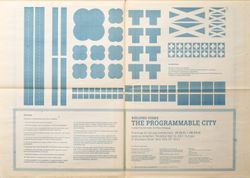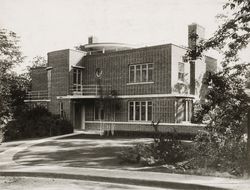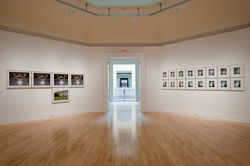drawings
AP178.S1.1988.PR07.SS9.024.2
Description:
Original file title : Edificio No 4 Zona sinistrada do Chiado - sistemas electricos (Sotecnica) This file includes details of the transformers, main distribution board rooms, fire detection system, control panel, and contract supply power distribution.
November 1997- June 1999
Electrical drawings, Recuperaçäo do Edifício dos Grandes Armazéns, Bloco C, Reconstrução do Chiado, Lisbon (folder 2 of 2)
Actions:
AP178.S1.1988.PR07.SS9.024.2
Description:
Original file title : Edificio No 4 Zona sinistrada do Chiado - sistemas electricos (Sotecnica) This file includes details of the transformers, main distribution board rooms, fire detection system, control panel, and contract supply power distribution.
drawings
November 1997- June 1999
drawings, textual records
AP178.S1.2002.PR05.SS1.009.2
Description:
Original file title: Arquitectura das Infraestruturas Process - Aguas e Turismo, S.A. Planos dos parques de Pedras Salgadas e Vidago This file includes documentation and plans for the transformer station. It also contains sketches and annotated plans.
2008-2010
Technical drawings and documentation, Parque de Vidago, Complexo Termal e Hotel Palace, Vidago (folder 2 of 4)
Actions:
AP178.S1.2002.PR05.SS1.009.2
Description:
Original file title: Arquitectura das Infraestruturas Process - Aguas e Turismo, S.A. Planos dos parques de Pedras Salgadas e Vidago This file includes documentation and plans for the transformer station. It also contains sketches and annotated plans.
drawings, textual records
2008-2010
Project
AP164.S1.1997.D1
Description:
The project series documents an entry for a competition organised by the Ajuntament de Palma to transform an old factory into a cultural center. The firm identified this project as number 100. Abalos & Herreros worked with Arturo Vila, Jose Luis Pujol and Angel Jaramillo. Documenting the project are conceptual and design development drawings, and textual documentation.
1994-1997
Centro Flassaders en Palma de Mallorca, Spain (1997)
Actions:
AP164.S1.1997.D1
Description:
The project series documents an entry for a competition organised by the Ajuntament de Palma to transform an old factory into a cultural center. The firm identified this project as number 100. Abalos & Herreros worked with Arturo Vila, Jose Luis Pujol and Angel Jaramillo. Documenting the project are conceptual and design development drawings, and textual documentation.
Project
1994-1997
The City Decoded
What if we played to re-imagine Montreal? After decoding the spatial policies linked to the planning of your city, it is your turn to rethink the urban fabric by combining houses, stores, parks, factories and corner stores. Montreal is transformed into a board game and its buildings and roads turned into game pieces. Noise management, sunlight, pollution and mixed-use(...)
The Other Architect
7 February 2016 to 21 February 2016
The City Decoded
Actions:
Description:
What if we played to re-imagine Montreal? After decoding the spatial policies linked to the planning of your city, it is your turn to rethink the urban fabric by combining houses, stores, parks, factories and corner stores. Montreal is transformed into a board game and its buildings and roads turned into game pieces. Noise management, sunlight, pollution and mixed-use(...)
The Other Architect
drawings
Quantity:
20 File
ARCH46932
Description:
cashiers' offices, waiting rooms, closets, driveway illumination, non-standard windows, transformer vault, arcade door, granite plinth, bar equipment, parapet coping, copper roof, service elevator guards, convector unit, bathrooms, 2nd floor roof, flashing, service elevator, pipe ducts, radiator boxes
Cashiers' offices, waiting rooms, closets, driveway illumination, non-standard windows
Actions:
ARCH46932
Description:
cashiers' offices, waiting rooms, closets, driveway illumination, non-standard windows, transformer vault, arcade door, granite plinth, bar equipment, parapet coping, copper roof, service elevator guards, convector unit, bathrooms, 2nd floor roof, flashing, service elevator, pipe ducts, radiator boxes
drawings
Quantity:
20 File
The exhibition is an introduction to the work and life of Ernest Isbell Barott, a Montréal architect who practised from 1912 to 1966. The drawings and photographs in the exhibition are largely drawn from the Ernest Isbell Barott Archive at the CCA. Ernest Barott’s career coincided with a period of profound physical and social change in Canada, a time of national and civic(...)
1440 rue Sainte-Catherine Ouest
5 June 1985 to 6 September 1985
Ernest Isbell Barott, architecte/architect : une introduction/an introduction
Actions:
Description:
The exhibition is an introduction to the work and life of Ernest Isbell Barott, a Montréal architect who practised from 1912 to 1966. The drawings and photographs in the exhibition are largely drawn from the Ernest Isbell Barott Archive at the CCA. Ernest Barott’s career coincided with a period of profound physical and social change in Canada, a time of national and civic(...)
1440 rue Sainte-Catherine Ouest
drawings
Dessins de structure
ARCH8654
Description:
Dessins de structure : plans d'armature et de coffrage pour le grand perron de la cour d'honneur, les hourdis ailes H et H', la citerne à cadavres H'3 et la plate-forme pour l'entrée des transformateurs, aile L. Aile K : plans et coupes de l'aile, incluant un plan de la salle des promotions (dessins 1356 à 1359, 1361, 1372, 1373A, 1376 à 1378).
1930
Dessins de structure
Actions:
ARCH8654
Description:
Dessins de structure : plans d'armature et de coffrage pour le grand perron de la cour d'honneur, les hourdis ailes H et H', la citerne à cadavres H'3 et la plate-forme pour l'entrée des transformateurs, aile L. Aile K : plans et coupes de l'aile, incluant un plan de la salle des promotions (dessins 1356 à 1359, 1361, 1372, 1373A, 1376 à 1378).
drawings
1930
This exhibition features Italian photographer Guido Guidis photographs of the Brion family mausoleum in Italy, considered to be architect Carlo Scarpa’s masterpiece. The artist’s 54 colour photographs reveal the beauty of the funerary complex, its clean architectural lines, and the poetic nature of Scarpa’s work. By concentrating on particular architectural features,(...)
Octagonal gallery
11 September 2009 to 10 January 2010
Carlo Scarpa's Tomba Brion: Photographs by Guido Guidi, 1997-2007
Actions:
Description:
This exhibition features Italian photographer Guido Guidis photographs of the Brion family mausoleum in Italy, considered to be architect Carlo Scarpa’s masterpiece. The artist’s 54 colour photographs reveal the beauty of the funerary complex, its clean architectural lines, and the poetic nature of Scarpa’s work. By concentrating on particular architectural features,(...)
Octagonal gallery
Project
AP143.S4.D14
Description:
File documents an executed project for House VI, a weekend/vacation house designed for Richard and Suzanne Frank for a six-acre lot at Great Hollow Road, Cornwall, Connecticut. The file also includes material for renovations to House VI undertaken in 1983, 1986, and 1989-1990. Material in this file was produced between 1971 and 1989. The 1,500 square foot plan of House VI comprises a kitchen, dining room, living room and study on the ground floor, and a bedroom and bathroom on the second floor. The most notable formal and compositional ambiguities of House VI are the two staircases, one green, and the other red and positioned on the ceiling. Documents include drawings by Eisenman concerning the geometric operations at the origin of House VI (DR1994:0134:055-067), conceptual drawings (DR1994:0134:001-068; DR1994:0134:086-130; DR1994:0134:131-160), numerous colour studies of the elevations (DR1994:0134:262-343), a presentation panel (DR1994:0134:521) notes (DR1994:0134:779-782), and a first set of working drawings and "check set," completed on 30 Aug. 1973, (DR1994:0134:667-689). Documents also include drawings for major revisions which occurred from 3 October 1973 through August 1974, photocopies of photographs of the house under construction (DR1994:0134:783-805), and a copy of the site survey (DR1994:0134:806). Planned and executed renovations to House VI began in 1983. Documents relating to unexecuted renovations and additions of 1983 includes drawings (DR1994:0134:604-615), a "bid set" and annotated copies (DR1994:0134:552 and DR1994:0134:554-570; copies: DR1994:0134:646-655), and a photocopy of the site plan indicating Eisenman's initial ideas (DR1994:0134:224). Documents relating to unexecuted renovations and additions of 1986 includes seven drawings (DR1994:0134:553 and DR1994:0134:628-633). House VI was extensively rebuilt between 1988 and 1990. The renovations included the replacement of the exterior plywood walls, the insertion of steel reinforcement, a new roof with skylights, the replacement of the original stucco by a coat of Finestone, the repainting of the interior, and the addition of a plexiglas barrier to the staircase. Documents relating to the renovations of 1988-90 include original and photocopied detail drawings, an interior paint schedule by Eisenman's office, correspondence, original and photocopied technical literature, an incomplete copy of the specifications, and a copy of the original survey map (identical to DR1994:0134:806). There are also numerous photographs of the building before, during and after renovation, one photograph of presentation axonometrics for House VI, and one photograph of Eisenman's office. Documents relating to a publication on House VI include: notes (DR1994:0134:807-853), the book mock-up (DR1994:0134:854-855), and fragments of the original coloured transformation diagrams (DR1994:0134:530-531). File contains conceptual drawings, including plans, axonometrics, and sections - many black felt-tip pen and/or coloured felt-tip pen on tracing paper; and reprographic copies - mostly photocopies on wove paper. Design development drawings include site plans, plans, elevations, sections, and axonometrics - some graphite and/or coloured pencil on tracing paper and some pen and black ink and/or graphite on tracing vellum; and reprographic copies - some photocopies on wove paper and some sepia prints on mylar. Schematic drawings include site plans, plans, elevations, and sections - all pen and black ink on mylar; and reprographic copies - many blackline prints on wove paper. Working drawings include site plans, plans, elevations, sections, electrical drawings, HVAC drawings, structural drawings, and detail drawings - some coloured pencil on blueline prints on wove paper; and reprographic copies - mostly blueline prints on wove paper. Presentation drawings include plans, elevations, and axonometrics - some pen and black ink and/or transparent coloured adhesive film on mylar and some translucent adhesive coloured film on cardboard; and reprographic copies - mostly photocopies on wove paper. Model includes one finished model - grey, white, and silver paint on wood and Fome-Cor with plastic sheets. Notes and documents include manuscripts - mostly black felt-tip pen on wove paper; reprographic copies - mostly photocopies on wove paper; and a land surveyor plan - one blueline print on wove paper. Book project includes layout drawings - some black felt-tip pen on ruled paper; reprographic copies - all photocopies on wove paper; manuscripts - mostly black felt-tip pen on wove or ruled paper; one sample piece of grey cardboard used as backing for some of the presentation drawings; and sets of drawings in the form of book dummies - mostly pen and coloured ink and/or black felt-tip pen on photocopies on wove paper. Detail drawings include elevations, sections, details - mostly graphite on tracing paper. The linear cm of documents includes sets, reprographic copies and manuscripts. Notes and documents include elevations, sections, and details - some graphite on photocopies on wove paper; two sets of drawing copies, some with changes - mostly photocopies on wove paper; reprographic copies - mostly photocopies on wove paper; manuscripts - many graphite on wove paper; ephemera includes trade pamphlets; and photographs include colour images of House X prior to and during one of the renovations.
1971-1989
House VI, Cornwall, Connecticut
Actions:
AP143.S4.D14
Description:
File documents an executed project for House VI, a weekend/vacation house designed for Richard and Suzanne Frank for a six-acre lot at Great Hollow Road, Cornwall, Connecticut. The file also includes material for renovations to House VI undertaken in 1983, 1986, and 1989-1990. Material in this file was produced between 1971 and 1989. The 1,500 square foot plan of House VI comprises a kitchen, dining room, living room and study on the ground floor, and a bedroom and bathroom on the second floor. The most notable formal and compositional ambiguities of House VI are the two staircases, one green, and the other red and positioned on the ceiling. Documents include drawings by Eisenman concerning the geometric operations at the origin of House VI (DR1994:0134:055-067), conceptual drawings (DR1994:0134:001-068; DR1994:0134:086-130; DR1994:0134:131-160), numerous colour studies of the elevations (DR1994:0134:262-343), a presentation panel (DR1994:0134:521) notes (DR1994:0134:779-782), and a first set of working drawings and "check set," completed on 30 Aug. 1973, (DR1994:0134:667-689). Documents also include drawings for major revisions which occurred from 3 October 1973 through August 1974, photocopies of photographs of the house under construction (DR1994:0134:783-805), and a copy of the site survey (DR1994:0134:806). Planned and executed renovations to House VI began in 1983. Documents relating to unexecuted renovations and additions of 1983 includes drawings (DR1994:0134:604-615), a "bid set" and annotated copies (DR1994:0134:552 and DR1994:0134:554-570; copies: DR1994:0134:646-655), and a photocopy of the site plan indicating Eisenman's initial ideas (DR1994:0134:224). Documents relating to unexecuted renovations and additions of 1986 includes seven drawings (DR1994:0134:553 and DR1994:0134:628-633). House VI was extensively rebuilt between 1988 and 1990. The renovations included the replacement of the exterior plywood walls, the insertion of steel reinforcement, a new roof with skylights, the replacement of the original stucco by a coat of Finestone, the repainting of the interior, and the addition of a plexiglas barrier to the staircase. Documents relating to the renovations of 1988-90 include original and photocopied detail drawings, an interior paint schedule by Eisenman's office, correspondence, original and photocopied technical literature, an incomplete copy of the specifications, and a copy of the original survey map (identical to DR1994:0134:806). There are also numerous photographs of the building before, during and after renovation, one photograph of presentation axonometrics for House VI, and one photograph of Eisenman's office. Documents relating to a publication on House VI include: notes (DR1994:0134:807-853), the book mock-up (DR1994:0134:854-855), and fragments of the original coloured transformation diagrams (DR1994:0134:530-531). File contains conceptual drawings, including plans, axonometrics, and sections - many black felt-tip pen and/or coloured felt-tip pen on tracing paper; and reprographic copies - mostly photocopies on wove paper. Design development drawings include site plans, plans, elevations, sections, and axonometrics - some graphite and/or coloured pencil on tracing paper and some pen and black ink and/or graphite on tracing vellum; and reprographic copies - some photocopies on wove paper and some sepia prints on mylar. Schematic drawings include site plans, plans, elevations, and sections - all pen and black ink on mylar; and reprographic copies - many blackline prints on wove paper. Working drawings include site plans, plans, elevations, sections, electrical drawings, HVAC drawings, structural drawings, and detail drawings - some coloured pencil on blueline prints on wove paper; and reprographic copies - mostly blueline prints on wove paper. Presentation drawings include plans, elevations, and axonometrics - some pen and black ink and/or transparent coloured adhesive film on mylar and some translucent adhesive coloured film on cardboard; and reprographic copies - mostly photocopies on wove paper. Model includes one finished model - grey, white, and silver paint on wood and Fome-Cor with plastic sheets. Notes and documents include manuscripts - mostly black felt-tip pen on wove paper; reprographic copies - mostly photocopies on wove paper; and a land surveyor plan - one blueline print on wove paper. Book project includes layout drawings - some black felt-tip pen on ruled paper; reprographic copies - all photocopies on wove paper; manuscripts - mostly black felt-tip pen on wove or ruled paper; one sample piece of grey cardboard used as backing for some of the presentation drawings; and sets of drawings in the form of book dummies - mostly pen and coloured ink and/or black felt-tip pen on photocopies on wove paper. Detail drawings include elevations, sections, details - mostly graphite on tracing paper. The linear cm of documents includes sets, reprographic copies and manuscripts. Notes and documents include elevations, sections, and details - some graphite on photocopies on wove paper; two sets of drawing copies, some with changes - mostly photocopies on wove paper; reprographic copies - mostly photocopies on wove paper; manuscripts - many graphite on wove paper; ephemera includes trade pamphlets; and photographs include colour images of House X prior to and during one of the renovations.
File 14
1971-1989
drawings
Quantity:
22 File
ARCH44877
Description:
Building "A", panels over toilet openings; Building "B", 1st floor arrangement, locker bases, partitions, ward screens, lockers, cupboard doors; "C" Building, basketball backstops, badminton courts, transformer pit, window sill, exterior sash, partition, projection room openings, chapel confessional, stairs to stage, toilet and scrub-up-room, entrance canopy, sink and cupboard, tile pattern in dining room
Building "A", Building "B", Building "C"
Actions:
ARCH44877
Description:
Building "A", panels over toilet openings; Building "B", 1st floor arrangement, locker bases, partitions, ward screens, lockers, cupboard doors; "C" Building, basketball backstops, badminton courts, transformer pit, window sill, exterior sash, partition, projection room openings, chapel confessional, stairs to stage, toilet and scrub-up-room, entrance canopy, sink and cupboard, tile pattern in dining room
drawings
Quantity:
22 File


